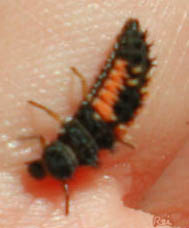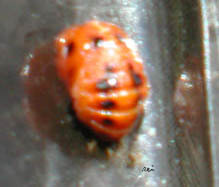Birds
Note: it is illegal to keep wild native animals (mammals, reptiles, and native bird species) without a permit.
Home.
Insects
 Successful rearing of ladybug
larvae. Twice now, I have taken ladybug larvae indoors. These
particular larvae look (as several sites put it) sort of like tiny
black alligators or crocodiles, with spikes and orange markings
(markings and coloration vary by ladybug variety), and six stubby legs
near the front of the body. The peppermint plant (in a pot, mind you;
peppermint is a nasty weed) seems to get lots of them, and adult
ladybugs seem to like hanging out on the perniciously spreading tansy
I foolishly planted one year. Well, this year I found one larvae
sitting indoors on the kitchen table (perhaps from a peppermint
cutting, perhaps stuck to someone's shirt); one that got stuck in the
dog's fur, and one lost on a hops vine. I took all three, put them in
a large plastic container, and added some aphid-covered leaves from
the cherry tree. (That's where the big black ants have their favorite
aphid farms in early summer (they started farming aphids on my
scallions in fall!). I had to be very careful to knock all the big
black ants off, because I think one thing they do is patrol around to
kill anything that might like to harm their aphids, and I suspect to
them ladybug larvae may be just another kill-on-sight target. These
particular aphids are black, some winged, some not.) I replaced the
leaves once or twice over the course of captivity. I observed also
that the larvae seem to occasionally go into "wander" mode, such as
when disturbed. They then run around at a rapid clip and seem to "run
away" from aphids they bump into! At last they settle down on a leaf
and then they start picking up aphids and sucking the juices out, one
by one, like good little ladybugs. Within a day or two the larvae had
gone though their last molt.
Successful rearing of ladybug
larvae. Twice now, I have taken ladybug larvae indoors. These
particular larvae look (as several sites put it) sort of like tiny
black alligators or crocodiles, with spikes and orange markings
(markings and coloration vary by ladybug variety), and six stubby legs
near the front of the body. The peppermint plant (in a pot, mind you;
peppermint is a nasty weed) seems to get lots of them, and adult
ladybugs seem to like hanging out on the perniciously spreading tansy
I foolishly planted one year. Well, this year I found one larvae
sitting indoors on the kitchen table (perhaps from a peppermint
cutting, perhaps stuck to someone's shirt); one that got stuck in the
dog's fur, and one lost on a hops vine. I took all three, put them in
a large plastic container, and added some aphid-covered leaves from
the cherry tree. (That's where the big black ants have their favorite
aphid farms in early summer (they started farming aphids on my
scallions in fall!). I had to be very careful to knock all the big
black ants off, because I think one thing they do is patrol around to
kill anything that might like to harm their aphids, and I suspect to
them ladybug larvae may be just another kill-on-sight target. These
particular aphids are black, some winged, some not.) I replaced the
leaves once or twice over the course of captivity. I observed also
that the larvae seem to occasionally go into "wander" mode, such as
when disturbed. They then run around at a rapid clip and seem to "run
away" from aphids they bump into! At last they settle down on a leaf
and then they start picking up aphids and sucking the juices out, one
by one, like good little ladybugs. Within a day or two the larvae had
gone though their last molt.  Then, a day or two later, they attached themselves to the
plastic (seemingly preferring it to the leaves!) and became pupae. To
this day I am annoyed that I miss the crucial brief time period in
which they shed their larval skin - the black stuff with the tufts.
In a brief window of time, they somehow manage to get the skin all the
way down to their "ankles," like crumpled pants -- it must involve
some undulation of the bodies or something, because their little
stubby legs at the front of their bodies sure couldn't push it all the
way down. Moreover, when the skin is shed, the insect-like legs go
with the skin! What's left are little bumps where the six larval legs
used to be. Then they gradually become encased in a hard shell
(orange, with black spots), and the transformation to an orange
ladybug takes several days.
Then, a day or two later, they attached themselves to the
plastic (seemingly preferring it to the leaves!) and became pupae. To
this day I am annoyed that I miss the crucial brief time period in
which they shed their larval skin - the black stuff with the tufts.
In a brief window of time, they somehow manage to get the skin all the
way down to their "ankles," like crumpled pants -- it must involve
some undulation of the bodies or something, because their little
stubby legs at the front of their bodies sure couldn't push it all the
way down. Moreover, when the skin is shed, the insect-like legs go
with the skin! What's left are little bumps where the six larval legs
used to be. Then they gradually become encased in a hard shell
(orange, with black spots), and the transformation to an orange
ladybug takes several days.  Oddly, all my captive ladybugs have come out pale
orange with no spots -- though apparently the spots and deep orange
color come out when the shell dries. Still, the ones I had were
spot-less hours later, even out in the sun. I hope I'm not doing
something wrong. Anyway, I worry a bit about the "wild" larvae --
those big black ants seem to patrol everywhere, and I can't
imagine they'd be kind to ladybug larvae.
Oddly, all my captive ladybugs have come out pale
orange with no spots -- though apparently the spots and deep orange
color come out when the shell dries. Still, the ones I had were
spot-less hours later, even out in the sun. I hope I'm not doing
something wrong. Anyway, I worry a bit about the "wild" larvae --
those big black ants seem to patrol everywhere, and I can't
imagine they'd be kind to ladybug larvae.